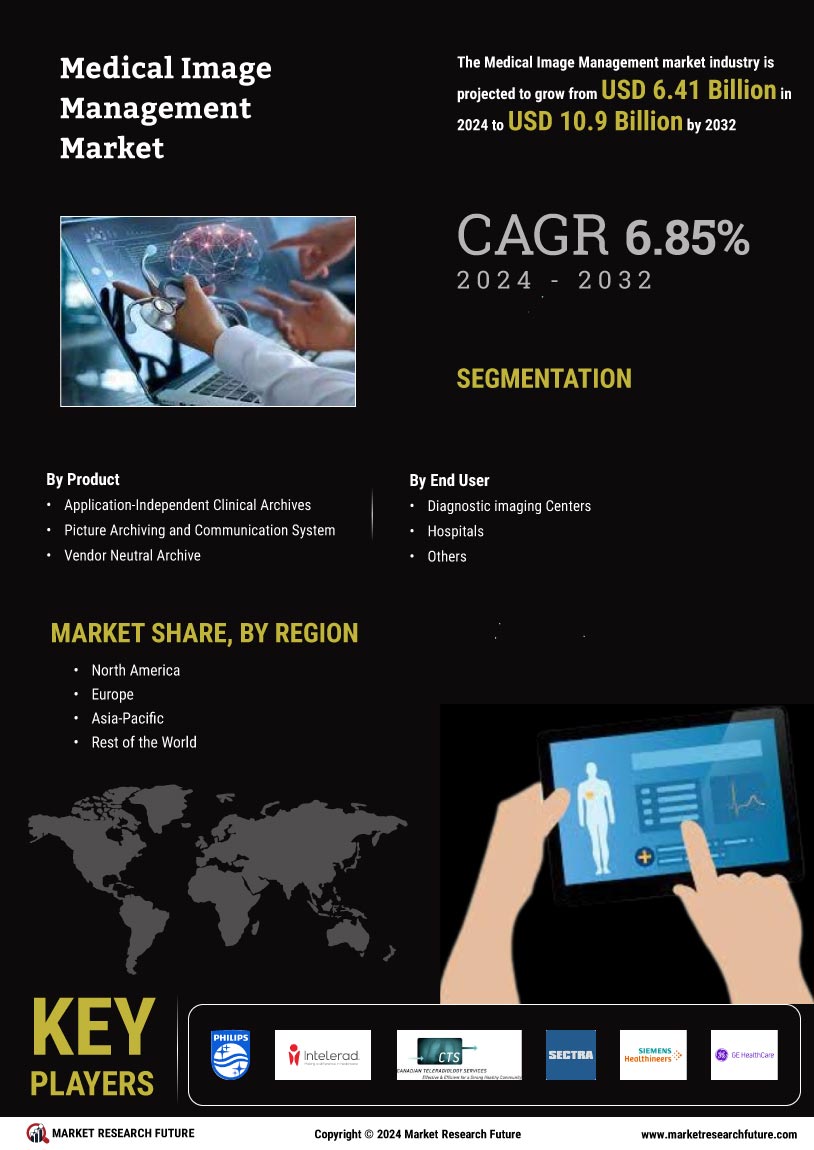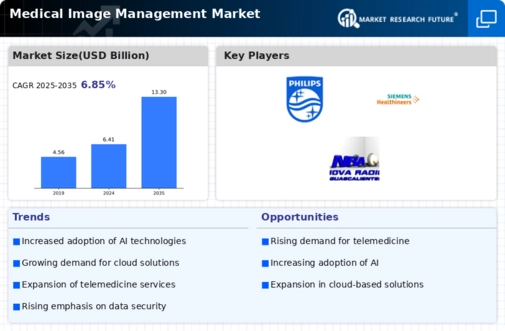Market Growth Projections
The Global Medical Image Management Market Industry is poised for substantial growth, with projections indicating a market size of 6.41 USD Billion in 2024 and an anticipated increase to 13.3 USD Billion by 2035. This growth trajectory suggests a compound annual growth rate of 6.86% from 2025 to 2035, reflecting the increasing adoption of advanced imaging technologies and solutions. The market's expansion is driven by various factors, including technological advancements, rising chronic disease prevalence, and growing telemedicine demand. These dynamics collectively indicate a robust future for the medical image management sector.
Rising Prevalence of Chronic Diseases
The Global Medical Image Management Market Industry is significantly influenced by the increasing prevalence of chronic diseases such as cancer, cardiovascular disorders, and neurological conditions. These diseases necessitate advanced imaging techniques for accurate diagnosis and monitoring. The World Health Organization indicates that chronic diseases account for a substantial portion of global mortality, prompting healthcare systems to invest in sophisticated imaging solutions. As the demand for early detection and ongoing management of these conditions grows, the market is expected to flourish, potentially reaching 13.3 USD Billion by 2035. This trend underscores the critical role of medical imaging in contemporary healthcare.
Growing Demand for Telemedicine Solutions
The Global Medical Image Management Market Industry is witnessing a notable shift towards telemedicine, driven by the increasing need for remote healthcare services. Telemedicine facilitates the sharing of medical images between healthcare providers and patients, enhancing accessibility and convenience. As healthcare systems worldwide adapt to this trend, the integration of medical imaging into telehealth platforms becomes essential. This shift is likely to propel market growth, as telemedicine is projected to become a standard practice in healthcare delivery. The industry's expansion is further supported by the anticipated compound annual growth rate of 6.86% from 2025 to 2035, reflecting the increasing reliance on remote healthcare solutions.
Regulatory Support for Imaging Technologies
The Global Medical Image Management Market Industry benefits from robust regulatory support aimed at promoting the adoption of advanced imaging technologies. Governments and health organizations are implementing policies that encourage the integration of innovative imaging solutions into healthcare systems. For example, regulatory bodies are streamlining approval processes for new imaging devices and software, facilitating quicker access to cutting-edge technologies. This supportive regulatory environment is likely to enhance market growth, as healthcare providers are more inclined to invest in advanced imaging solutions. As a result, the industry is expected to witness sustained growth, aligning with the broader trends in healthcare innovation.
Technological Advancements in Imaging Techniques
The Global Medical Image Management Market Industry is experiencing a surge in demand due to rapid advancements in imaging technologies. Innovations such as 3D imaging, artificial intelligence, and cloud-based solutions are enhancing diagnostic accuracy and efficiency. For instance, AI algorithms are increasingly utilized to analyze imaging data, potentially reducing the time required for diagnosis. This technological evolution is projected to contribute significantly to the market's growth, with the industry expected to reach 6.41 USD Billion in 2024. As healthcare providers adopt these advanced imaging techniques, the market is likely to expand further, driven by the need for improved patient outcomes.
Increasing Investment in Healthcare Infrastructure
The Global Medical Image Management Market Industry is positively impacted by the rising investment in healthcare infrastructure across various regions. Governments and private entities are allocating substantial resources to enhance healthcare facilities, which includes upgrading imaging technologies. This investment is crucial for improving diagnostic capabilities and patient care. For instance, many countries are expanding their healthcare budgets to incorporate advanced imaging systems, thereby fostering market growth. As healthcare infrastructure continues to evolve, the demand for efficient medical image management solutions is likely to increase, contributing to the industry's overall expansion.














